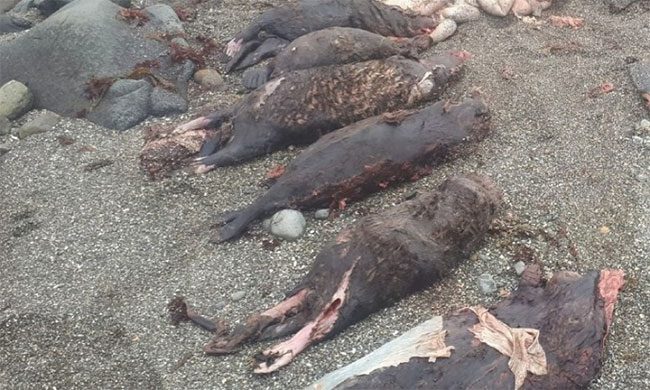Female Orcas Can Die from Having a Sea Otter Stuck in Their Mouth and Esophagus After Eating 6 Other Sea Otters.
Researchers in Russia discovered 7 perfectly preserved sea otters in the belly of a stranded killer whale (Orcinus orca), according to a study published on September 28 in the journal Aquatic Mammals. The unfortunate whale was found far from its usual hunting grounds, raising questions about what it was doing there. The female killer whale was discovered in 2020 along the coast of the Commander Islands, off the eastern region of Russia in the Bering Sea.

The intact sea otters were removed from the stomach of the stranded female killer whale. (Photo: Sergey V. Fomin).
The research team conducted an examination of the animal and found not only 7 remains of sea otters (Enhydra lutris) weighing a total of 117 kg but also 256 pieces of cephalopod beaks. One sea otter was lodged between the mouth and esophagus, which could have led to the killer whale’s death. There were several aspects of the killer whale that puzzled researchers. “This situation is very unusual because killer whales typically do not eat sea otters,” revealed Olga Filatova, a marine mammal researcher at Moscow University.
Instead, they typically hunt seals, sea lions, dolphins, and even other whales. Regardless of the prey species, they do not swallow their prey whole but tear it apart and only consume the tastiest parts, according to Filatova. Swallowing an entire sea otter is likely very difficult for a stranded killer whale, as adult sea otters can grow up to 1.5 meters long. The research team speculated that the killer whale might have done this because it was starving.
The researchers also analyzed the DNA of the killer whale and determined that this individual belonged to the Bigg’s killer whale population, which has a broad range from the Aleutian Islands and the Gulf of Alaska to the coastal waters of California. This is the first time a member of this killer whale population has been found in the western Pacific, prompting Filatova and her colleagues to hypothesize that the animal learned hunting strategies elsewhere. Foraging strategies are typically passed from mother killer whales to their young.
While the stranded killer whale raised several questions, it could also help answer many others. The sea otter population between the Aleutian Islands and the Gulf of Alaska is declining. Although some scientists suspect that killer whales are responsible for the decrease in the local sea otter population, this is the first direct evidence of such behavior.




















































